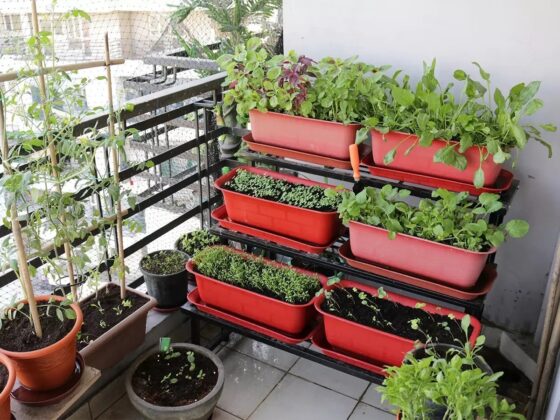Kitchen gardening is gaining unmatched popularity and for all the right reasons. If you want to grow your own food too, here’s what you need to know!
With organic food becoming costlier by the day, kitchen gardening is something everyone wants to try their hands at. And why not? You save money and get to have fresh, flavoursome veggies/ herbs/ fruits from your own garden. If we delve a little into its varied names, it’s called a potager in France and Kailyard in Scotland. Home Garden, Nutrition Garden, Kitchen Garden, or Vegetable Garden are some of its other names. Without much ado, let’s understand kitchen gardening in general and how you can set up your kitchen garden in India.
What is Kitchen Gardening?
For the curious hearts, kitchen gardening isn’t the same as regular gardening. This is because a kitchen garden is usually smaller and aesthetically more pleasing. It blends with how the entire house looks in terms of design. Besides, the production is meant for fresh consumption and not for sale. Conducive to growing vegetables, herbs, and fruits, kitchen gardens are more practical and more accessible. Not to forget, they are much prettier to look at; thanks to the geometric recurring patterns that kitchen gardens are synonymous with.
Benefits of Kitchen Gardening
- You get to eat more homegrown seasonal vegetables and herbs that are free from harmful pesticides.
- There’s better control over what goes in your meal when you are growing it yourself, making it a healthier option.
- Kitchen gardening is a very healthy way to involve the whole family in physical activity.
- Kitchen gardening also helps clean up a lot of air around your home.
- Your kitchen garden goes a long way in healing the environment around you.
Where To Put Your Kitchen Garden
Like any other garden, even a kitchen garden requires proper sunlight. The location you zero in on for your kitchen garden should get adequate sunlight for at least 4 to 5 hours a day, preferable morning sunlight..
These are some of the places you can consider having your own kitchen garden at-
Backyard Backyards are the most preferred areas to cultivate kitchen gardens because of their easy accessibility to sunlight, water, and other connected elements. The size of the backyard doesn’t really matter because you can go for a stacked kitchen garden. Herein, you will have layers of plants on the walls (also known as vertical gardening). This is a real space-saver and adds to the overall aesthetics of the place.
Terrace Terrace is another place you can consider having your kitchen garden at. The only issue will be tending to them and the extra rounds you’ll have to make to take your supplies. But then, the more effort, the sweeter the result, they say.
Window Sill If you have space issues, window sills become an equally promising area to have the plants for your kitchen garden. Apart from making the most mundane area look ultra-gorgeous, you’ll have fresh produce.
Pots If you are going to use pots (earthen or plastic) to grow your produce, you got to take care of the following two points:
- Proper space to help the plants grow
- Pots should have holes to help in proper drainage
Pro-tip: You can use milk cartons, used plastic bottles, etc. as pots for your kitchen garden.
Soil Usage
Soil forms the foundation of your kitchen garden. You can either buy the soil mix from nurseries or make your own. If you are enthusiastic about making your own, you would need to know that a 1:1:1 ratio of compost, cocopeat and garden soil is the standard mix.
While planting your vegetables or fruits for your kitchen garden, fill the container or make the bed with the standard mix. In case you are using pots, add in a few pebbles or crushed thermocol pieces to prevent clogging. Once you plant the seeds or vegetables, sprinkle some water to moisten the soil. However, don’t overwater as it leads to rotting of the roots.
Pro-Tip: To find out if the soil is dry, insert any of your fingers in the soil, preferably till the knuckle, to check if the soil is moist and water accordingly.
Vegetables To Grow In A Kitchen Garden
Planning to have a kitchen garden for yourself? Here are some vegetables you can grow:
Tomato
Tomatoes prefer particular growing conditions which include soil’s ideal pH level ranging between 6 and 6.8. After the plant grows 6 to 7 inches indoors, it is to be transplanted outdoors where it can get direct sunlight for 7 to 8 hours. Also the tomatoes you’ll have from your kitchen garden are bound to take your taste buds on an exquisite journey. Ready for that? But before that, read on how to grow tomatoes and grab your tomato seeds online to get started.
Brinjal
Brinjals require full sunlight of 5-6 hours and you can easily grow them in your terrace garden or kitchen garden. For that, you need to sow brinjal seeds in sandy-loam soil for best results. Please note that they need to be sown at a depth of 0.4 inches and for them to yield the best produce, you must keep the brinjal plants indoors. Water daily so the soil remains moist. These little details are known to go a long way when it comes to sowing brinjal seeds at home. Good luck!
With organic food becoming costlier by the day, kitchen gardening is something everyone wants to try their hands at. And why not? You save money and get to have fresh, flavoursome veggies/ herbs/ fruits from your own garden. If we delve a little into its varied names, it’s called a potager in France and Kailyard in Scotland. Home Garden, Nutrition Garden, Kitchen Garden, or Vegetable Garden are some of its other names. Without much ado, let’s understand kitchen gardening in general and how you can set up your kitchen garden in India.
What is Kitchen Gardening?

For the curious hearts, kitchen gardening isn’t the same as regular gardening. This is because a kitchen garden is usually smaller and aesthetically more pleasing. It blends with how the entire house looks in terms of design. Besides, the production is meant for fresh consumption and not for sale. Conducive to growing vegetables, herbs, and fruits, kitchen gardens are more practical and more accessible. Not to forget, they are much prettier to look at; thanks to the geometric recurring patterns that kitchen gardens are synonymous with.
Benefits of Kitchen Gardening

- You get to eat more homegrown seasonal vegetables and herbs that are free from harmful pesticides.
- There’s better control over what goes in your meal when you are growing it yourself, making it a healthier option.
- Kitchen gardening is a very healthy way to involve the whole family in physical activity.
- Kitchen gardening also helps clean up a lot of air around your home.
- Your kitchen garden goes a long way in healing the environment around you.
Where To Put Your Kitchen Garden

Like any other garden, even a kitchen garden requires proper sunlight. The location you zero in on for your kitchen garden should get adequate sunlight for at least 4 to 5 hours a day, preferable morning sunlight..
These are some of the places you can consider having your own kitchen garden at-
Backyard Backyards are the most preferred areas to cultivate kitchen gardens because of their easy accessibility to sunlight, water, and other connected elements. The size of the backyard doesn’t really matter because you can go for a stacked kitchen garden. Herein, you will have layers of plants on the walls (also known as vertical gardening). This is a real space-saver and adds to the overall aesthetics of the place.
Terrace Terrace is another place you can consider having your kitchen garden at. The only issue will be tending to them and the extra rounds you’ll have to make to take your supplies. But then, the more effort, the sweeter the result, they say.
Window Sill If you have space issues, window sills become an equally promising area to have the plants for your kitchen garden. Apart from making the most mundane area look ultra-gorgeous, you’ll have fresh produce.
Pots If you are going to use pots (earthen or plastic) to grow your produce, you got to take care of the following two points:
- Proper space to help the plants grow
- Pots should have holes to help in proper drainage
Pro-tip: You can use milk cartons, used plastic bottles, etc. as pots for your kitchen garden.
Soil Usage

Soil forms the foundation of your kitchen garden. You can either buy the soil mix from nurseries or make your own. If you are enthusiastic about making your own, you would need to know that a 1:1:1 ratio of compost, cocopeat and garden soil is the standard mix.
While planting your vegetables or fruits for your kitchen garden, fill the container or make the bed with the standard mix. In case you are using pots, add in a few pebbles or crushed thermocol pieces to prevent clogging. Once you plant the seeds or vegetables, sprinkle some water to moisten the soil. However, don’t overwater as it leads to rotting of the roots.
Pro-Tip: To find out if the soil is dry, insert any of your fingers in the soil, preferably till the knuckle, to check if the soil is moist and water accordingly.
Vegetables To Grow In A Kitchen Garden
Planning to have a kitchen garden for yourself? Here are some vegetables you can grow:
Tomato

Tomatoes prefer particular growing conditions which include soil’s ideal pH level ranging between 6 and 6.8. After the plant grows 6 to 7 inches indoors, it is to be transplanted outdoors where it can get direct sunlight for 7 to 8 hours. Also the tomatoes you’ll have from your kitchen garden are bound to take your taste buds on an exquisite journey. Ready for that? But before that, read on how to grow tomatoes and grab your tomato seeds online to get started.
Brinjal

Brinjals require full sunlight of 5-6 hours and you can easily grow them in your terrace garden or kitchen garden. For that, you need to sow brinjal seeds in sandy-loam soil for best results. Please note that they need to be sown at a depth of 0.4 inches and for them to yield the best produce, you must keep the brinjal plants indoors. Water daily so the soil remains moist. These little details are known to go a long way when it comes to sowing brinjal seeds at home. Good luck!
Chilli

Chilli seeds need to be germinated indoors in a warm climate before you can sow them in soil. Make sure you place the plant where it receives plenty of sunlight. Water it regularly so the soil is moist at all times but don’t overwater it, else it will wilt. You can learn more on how to grow chilli at home so you are sure of the nitty-gritty needed to grow chillies at home. Because we know how disheartening it can be to see plants wilt, we give our clients all the requisite details beforehand.
Onion

Onions are best sown during the months between August and October. You must sow onion seeds in a sunny spot in well-drained and fertilized soil to get your fresh supply of home-grown pesticide-free onions. Sow the seeds 1 inch deep in the soil. Maintain a distance of about half an inch or more between each seed. If you are planting rows directly in the garden, keep a space of at least 1 and a half to 2 feet between the rows. Onion seeds usually take only 7-10 days to germinate.
Bhindi/Ladyfinger

Ladyfinger, bhindi, or okra can be grown with the help of okra seeds during the warm months where they can receive 5 to 6 hours of daily sunlight. You’ll have to sow the seeds ½ inches deep and 7-8 inches apart (if sown outdoors) and 9-10 inches apart (if sown indoors). Be sure to water your ladyfinger plant in the morning to get the best results. For more details and to leave all apprehensions aside, read our guide on growing ladyfinger.
Bitter Gourd

To get the perfect produce of karela, sow Karela seeds in early spring. Make sure the soil you prepare is well-drained and rich in organic matter. Because bitter gourd grows on vines, it can grow up to 10 to 15 ft long. Don’t forget to water the plant regularly to keep it moist. If you are looking for seeds to see your kitchen garden flourish with this green veggie, check out non-GMO bitter gourd seeds online.













